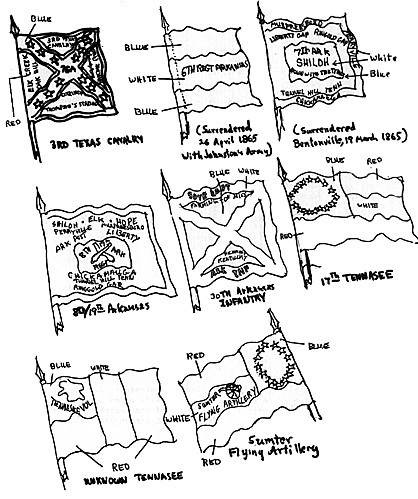 In a past issue James Hinds mentioned that the Romans would go to great
lengths in War or Diplomacy to recover lost "eagles". Curiously the Confederate
States of America went to some lengths to achieve the same ends. even after they had
been destroyed as a nation.
In a past issue James Hinds mentioned that the Romans would go to great
lengths in War or Diplomacy to recover lost "eagles". Curiously the Confederate
States of America went to some lengths to achieve the same ends. even after they had
been destroyed as a nation.
The evidence, such as it is, crops up in a letter from the Secretary of War to the 50th Congress, 1st Session, in 1888, shortly after the disputed Hayes-Tilden election. The Secretary, in his 20 February letter, was plagued by a surplus of Confederate flags, 544 in numbers not to mention 236 United States Flags which were recaptured at the close of hostilities. All had been kept in the basement in boxes from 1882 in the sub basement, in fact, of the State, War, and Navy Building (all three in one building--who would have dreamed?) until 1887 when the incumbent had them moved upstairs to the attic, as they were rotting in the basement.
A law was on the books at the time placing captured flags under the president's authority, but nobody was sure if this applied to flags captured from domestic rebels. The president seems to have been anxious to give the flags back to Confederate Veterans Societies--very altruistic for a man of Hayes reputation--but the temper of Congress was against the move so the surviving arms of the Confederacy lost their first recovery effort.
Eventually, somehow, the thought was introduced to President Theodore Roosevelt, about 1907. He carried the point, suggesting that it was unlikely the flags would form a rallying point for a second rebellion (for one thing, they were too moldy to be waved around.) Deciding to let bygones be bygones, the U.S. Government gave back the flags. I was able to find no record of what was done with the attic, but I'm sure the added space was put to good use, perhaps as a place to store unwanted civil servants who were "kicked upstairs".
Lest the reader assume that I am making all this up, he may check under "Flags", sub heading "Confederate States of America" in the Library of Congress, where upon he may obtain for review not only all of the bureaucratic memoranda and letters relating to the Secretary's littered attic, but a charming little volume, in faded color "Flags of the Confederate Armies" call numbers E545.F57 jointly produced by the United Daughters of The Confederacy and the United Confederate Veterans. Due to the incredible longevity of the human female, and the frailty of the male, the latter organization has disappeared from this earth, but the former soldiers on.
But I digress - the booklet contains color illustrations of the remnants of our once proud banners. By skimming both Confederate and Federal accounts it becomes obvious that about a third of the Confederate flags were surrendered by active regiments when the major Confederate Armies surrendered. Almost as many were taken from undefended Court Houses, warehouses in Richmond, Va. awaiting shipment to the troops, etc.
The remainder, sad to say, were actually taken from Confederate regiments, companies, or what have you in open battle.
In mitigation, I right add that some were captured under remarkable circumstances.
The banner of the 9th Texas, for example. As the Texans were attacking the 27th Ohio with volley and cold steel, one ornery Yankee, at the moment his regiment was breaking, shot the Texas color bearer, ran forward, seized the colors, and sprinted all the way back to his departing comrades, carrying off not only the flag, but 5 or 6 rounds of good Confederate lead from a nearby Texas officer whose marksmanship was up to State standards, but whose revolver was apparently a .32. This incident was reportedly at Antietam, or Sharpsburg as it is properly called. I did not make it up! It's in the records.
Since some of you may be unable to make the trip, I have included some Confederate Flags sketches in the article. The lettering is usually white on red or blue, blue or black on white.
Readers will note that blue flags are quite common in the Western Armies, the traditional "Battle Flag" 4'x4' or sometimes in the 4'x6' "Naval" rectangle dominant in the East, though some old "Stars and Bars" patterns were captured very late in the war in the East.
The Gold Bouillon commonly portrayed as a fringe on flags was rarely present on the remnants returned to the U.C.V. and D.A.R.
Should you wish to know whether this was natural to the particular flag, or a result of Yankee ministrations, save your six cents--I don't know! Your editor does, however, have a file of sketches on Confederate Battle (and miscellaneous) flags, and more will be presented if the reader response is not wholly unfavorable.
Back to The Armchair General Vol. 2 No. 2 Table of Contents
Back to The Armchair General List of Issues
Back to MagWeb Master Magazine List
© Copyright 1969 by Pat Condray
This article appears in MagWeb (Magazine Web) on the Internet World Wide Web. Other military history articles and gaming articles are available at http://www.magweb.com
